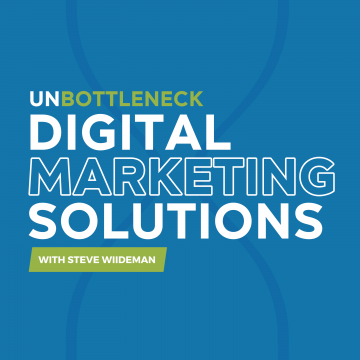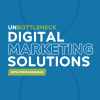Podcast: Play in new window | Download
In this episode, Steve Wiideman is joined by podcast expert David Perez, to discuss why and how you should use a podcast to build your brand and business.
About Our Guest: David Perez
David Perez wears many hats within the podcasting world. He is the founder of Talking Silk Worm, a podcast production company that guides health and wellness coaches through planning and launch success. He is also the host of the Audience Coach Podcast and joins us here to share his knowledge and expertise as an entrepreneur with a lens on meditation, minimalism, positivity and growth.
Featured in this episode:
- Podcasting basics as a digital marketing asset
- How to Start a Podcast
- How to Make Money from a Podcast
- Common Podcasting Mistakes
- Making the Choice to Launch a Podcast
What Is a Podcast? The Basics of this Mighty Asset
A podcast is an audio platform that you can use to appeal to a wider audience. There are a wide range of podcasts available in the digital space – interviews, poetry, true crime, etc. – and quite frankly, anyone can have a podcast. Depending on your personal or business goals, podcasts can serve as a source to:
- Generate leads
- Build authority and trust in your niche
- Grow your business
With the proper structure and development, your podcast can become a solid asset for your business or brand
A podcast is the most personal format because the audience can solely connect with you, your brand and/or business. Your voice, tone, humor, personal stories and overall knowledge are going to be the cues that can increase (or even decrease) audience engagement.
How to Start a Podcast
The idea of starting a podcast is exciting when you think about the unlimited possibilities of spreading insightful ideas and knowledge. Here are some essentials to pay attention to as you move forward:
However, you must start with a mindset that is centered around your audience. Everything you do should be about them, not you.
Before getting started, you want to identify who your target audience is – who are they, how do they like to be talked to, what topics so they want to hear about.
This information will guide you as you develop your content.
Focus on Solid Technical Production
You can’t build trust and authority with bad audio! You may have great content, but it will not matter, if your audience can’t enjoy it because of bad sound quality. Make sure that you have the appropriate recording accessories (microphone, headphones, etc.) to deliver an engaging episode, free of any sound / tech issues.
Hosting Platforms
Finding a hosting platform that fits your needs and your budget will be an essential step to get started. A hosting platform gives you a digital space to store your audio files and distribute them to directories such as iTunes, Spotify and Google. Some popular hosting platforms include Podbean, Blubrry, and Buzzsprout.
Pro-Tip: iTunes — now officially rebranded as “Apple Podcasts” — continues to be the most popular podcast directory. When you publish your podcast, you will want to make sure that it is available on Apple Podcasts by the time you start promoting.
How to Make Money from a Podcast
Yes, you can make money from your podcast! Whether you’re a podcast newbie or veteran, you can earn and generate revenue.
If you have a business behind your podcast, the easiest way to earn revenue is by selling your product or service.
If you do not have a business behind your podcast, there are two ways you can earn revenue:
Affiliate Links
If you sign-up for an affiliate program, you (the affiliate) earn a commission for promoting a company’s product(s) on your podcast thus leading your listeners to buy those products using a custom URL (or affiliate link) to track sales.
Sponsors
Contrary to popular belief, you can secure a podcast sponsor no matter how small or large your following is. If you have a small or medium following, you can reach out to businesses directly. However, if you have a larger following, you can go through advertising programs with national sponsors such as Midroll.
Common Podcasting Mistakes & Pitfalls to Avoid
In order to deliver the best podcast content, you will need to avoid common mistakes that can cause listeners to become disengaged. Consider the following:
Go Beyond Broad Conversations: Get Specific
Before you record an episode, it is important to be very specific about the topic you plan to discuss. You want to avoid broad conversations that lack structure, focus and direction as it can lose the attention of your listeners. Narrow down the scope of your content and try to focus on one topic at a time so your audience can be fully engaged.
Commit to Consistency
According to Perez, over 90% of podcasters stop after the first 3-4 months. The truth is, the success of your podcast will not come overnight. It takes time and consistency to build a loyal audience and eventually make money. Therefore, you must be in it for the long-term in order to reap the full benefits. Whether you are thinking about starting a podcast or already have one, take the time to set realistic goals and work towards those goals on a consistent basis.
Audio Quality Rules the Day
Your audience deserves quality when they tune into your podcast, which includes clear and crisp audio. Your audio should be clear of any static, buzzing and other annoying feedback. Take the time to invest in the appropriate recording gear – microphones, headphones, soundboard, etc. – to ensure your audience has a pleasant audio experience.
To Podcast or Not to Podcast? Making the Choice
The purpose of a podcast is to build authority and trust within your industry or niche. Because podcasts are solely audio, you must be mindful of how your target audience will digest the information you share. For example, if you are a photographer and you wish to explain how to shoot and edit the best photos, an audio podcast may not be the best option. In this case, you may want to go with a visual approach to thoroughly demonstrate your topic.
Keep in mind that many podcast creators, including our Unbottleneck podcast team, record both audio and video files and incorporate the visual element on platforms like YouTube, while rolling out the audio on popular podcasting platforms.
Keep up with the best podcasting and digital marketing essentials. Follow Steve on LinkedIn!




